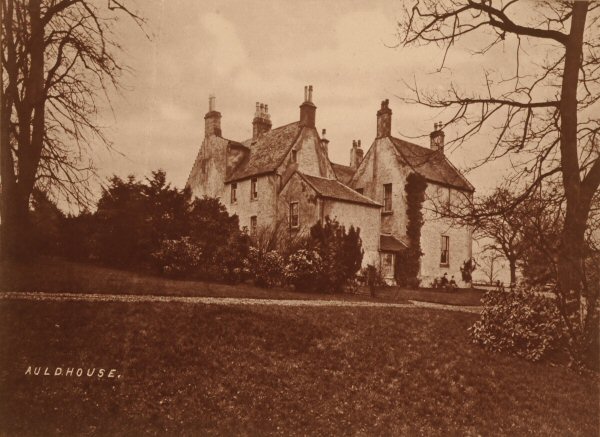

AULDHOUSE, now held by the trustees of the late Sir William Stirling Maxwell, Bart., is in the parish of Eastwood, near Glasgow.
The present mansion house has been erected at four periods; the latest addition to the house was built by the father of the late Sir John Maxwell, and this with former additions has made it large and commodious.
Over the fire-place in the kitchen, which was built in 1631, there is the following -
"THE BODIE FOR THE SAVL WAS FRAMD : THIS HOVS THE BODY FOR :
IN HEAVNE FOR BOTH MY PLACE IS NAMD IN BLISS MY GOD T'ADOR. - 1631."
It is supposed that this inscription was the work of Mr. George Maxwell of Auldhouse, minister of Mearns, or his son, Mr. John Maxwell, younger of Auldhouse, minister of the High Church, Glasgow, The latter, by bond dated 20th May, 1631, narrates that he and his father have founded, and are of intention to build houses, one or more, and to repair houses already built upon at their equal expenses; and Mr. John Maxwell becomes bound to disburse penny about with his father.
The lands of Auldhouse came into possession of the Pollok Maxwell family about the middle of the fifteenth century. Thomas Maxwell, the second of the family who possessed them, is designated of Auldhouse in 1517, and it is very probable that his father, Thomas Maxwell, who first appears on record in 1476, received these lands, as a suitable portion for a younger son, from his father, Thomas Maxwell, who was laird of Pollok from 1429 to 1450.
John Maxwell, seventh of Auldhouse, 1634-1666, was educated for the church, and became minister of the parish of Eastwood about 1620, where he continued to labour till 1630, when he was translated to the High Church, Glasgow. He was elected Dean of Faculty of the University in 1632, and appointed to the higher office of Rector in 1636. The office thus filled by Mr. Maxwell was also held by his son, Sir George Maxwell, who succeeded his cousin Sir John in the estate of Pollok, and by his grandson, Sir John, a Baronet of Nova Scotia in 1682, and Lord Justice Clerk in 1702.
Mr. Maxwell lived in the troublous times of the Church. He went to Ireland in 1640, where he received a clerical appointment. He continued there till about the year 1643, when, on the breaking out of the rebellion, he returned to Scotland. Having by this time modified his dislike to the Covenant, he was appointed a second time minister of Eastwood, but was still suspected by the Covenanters of a leaning to the Episcopal form of church government. At last he was ordered by the General Assembly to give forth a particular renunciation of Episcopacy.
Robert Pollok, otherwise Hutcheson, (1) of Auchingray, married Grizzel Maxwell of Blawart Hill, a niece of Sir George Maxwell of Auldhouse and Pollok. He had been very anxious to make the purchase of Auldhouse, and pressed and entreated Sir George to sell it to him, saying, "His heart and eye were in it, and God's curse be on them that shall get it, if he do not."
In 1710 the lands of Auldhouse became the property of Robert Sanders, printer and bookseller in Glasgow, as vassal to my Lord Pollok. Semple, in his history of Renfrewshire, says the house and lands came afterwards to Mr. John Wardrop, bailie of the regality of Glasgow; he was succeeded by his son Robert, who, in the year 1782, alienated the house and lands of Auldhouse to Jean Maxwell, sister of Sir James Maxwell of Nether Pollok.
This Robert Sanders of Auldhouse, 10th November, 1726, disponed to the Merchants' House of Glasgow a bond of one thousand merks, due by James Dunlop of Househill, to continue at interest until it amounted to two thousand merks, the interest of which, he directed, should be given as an apprentice fee to a poor boy, son of a burgess of the craft rank and freeman of his corporation, to be bound to any lawful calling of the craft rank. The deed is registered in the town court books of Glasgow 20th May, 1730.
On the 9th February, 1728, by another deed, he mortified to the Merchants' House the whole of his estate of Auldhouse, for the payment of one hundred pounds Scots yearly as a bursary at the College of Glasgow to a young man, a student of Divinity, for five years, and of one hundred merks as apprentice fees to poor boys, sons of honest poor burgesses merchants or tradesmen, to be bound to any lawful trade or calling within the city of Glasgow, the apprentice fee being payable year and day after admission. Subsequently he bequeathed the whole of his property to the Merchants' House for the better endowment of his mortification.
The Merchants' House, in the year 1744, sold about four acres of Nether Auldhouse to the Printfield Company of Pollokshaws (2) for the payment of an annual feu-duty, and in the following year they sold the remainder of the estate to the above-mentioned John Wardrop, a writer in Glasgow, for a sum in hand and a yearly feu-duty. Subsequently Wardrop's portion, which formed the greater part of the Auldhouse estate, was re-acquired by the Maxwells of Nether Pollok.
(1) Son of Elizabeth, one of the three sisters and heiress portioners of George and Thomas Hutcheson, the founders of Hutchesons' Hospital in Glasgow, who, on inheriting Auchingray, took the name of Hutcheson.
(2) This was the first regular printfield here, or, we suppose, in Scotland. Archibald Ingram (Provost 1762-3) was at the head of it, and John Glassford of Dugalston and others were partners.
Back to Contents